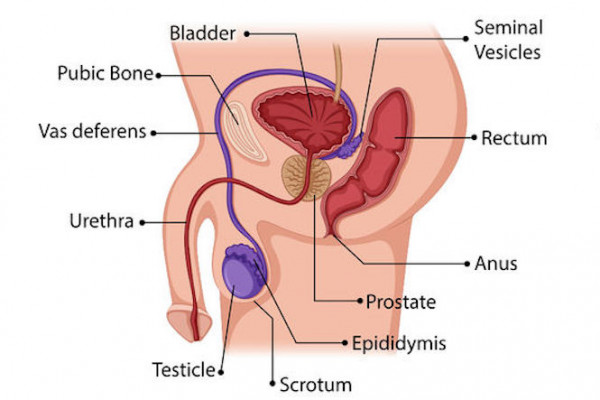Epididymo-orchitis
Key points about epididymo-orchitis
- Epididymo-orchitis is an inflammation of the tube that stores and carries sperm, and/or of the testicle.
- It's normally caused by infection, most often a sexually transmitted infection (STI) or a urinary tract infection (UTI).
- Antibiotics are usually effective in clearing the infection.
- If you use a condom every time you have sex you are much less likely to get epididymo-orchitis.
- See your doctor straight away if you think you have epididymo-orchitis.
- NOTE: Sudden severe pain in your testicle or scrotum can be due to a twisted testicle. This is serious and you need to see a doctor straight away.

- Epididymitis means inflammation of the epididymis (a tube that stores and carries sperm); orchitis is an inflammation of one or both testicles (where sperm is made).
- In men who are sexually active, epididymo-orchitis is usually due to a sexually transmitted infection (STI), eg, chlamydia or gonorrhoea.
- If you use a condom every time you have sex you're much less likely to get epididymo-orchitis.
- Sometimes epididymo-orchitis is due to a urinary tract infection (UTI) – this is more common in men over 35 years of age.
- See your doctor straight away if you think you have epididymo-orchitis. Antibiotics usually clear it without complication.
| Sudden severe pain in your testicle or scrotum can be due to a twisted testicle. This is serious and you need to see a doctor straight away. |
|---|
The image below shows the location of the epididymis and testicle inside the scrotum.

Image credit: 123rf
Most cases are caused by infection. The 2 most common infections leading to epididymo-orchitis are sexually transmitted infections (STIs) and urinary tract infections (UTIs).
- STIs (eg, chlamydia or gonorrhoea) are the most common cause in men under 35 years of age. These are caught from having unprotected sex with someone who has the STI.
- UTI is the most common cause in men over 35 years of age. It occurs when bacteria that cause UTIs (eg, E. coli) track down the vas deferens (the tube that carries sperm from the epididymis to the urethra).
Other causes include:
- mumps
- other viral, bacterial, or fungal infections.
Epididymo-orchitis occurs more commonly in men 15–30 years of age, especially those who are sexually active, and in men aged over 60 years of age. It doesn't occur very often before puberty.
Your risk of getting epididymo-orchitis is increased if you:
- have a catheter or other instrument inserted into your urethra
- don’t use condoms
- practice insertive anal sex
- have mumps – about 3 in 10 boys who have mumps after puberty develop orchitis.
Symptoms usually develop quickly and may include:
- swelling and pain in the affected testicle or scrotum
- sometimes discharge from the penis (especially if an STI is the cause)
- sometimes pain on passing urine (especially if a UTI is the cause)
- a high temperature (fever) and generally feeling unwell.
The symptoms of epididymo-orchitis are very similar to a condition called torsion of the testes, which occurs when a testicle twists and the blood supply to it is stopped. Unless the testicle is untwisted, it will die. This is a medical emergency and you need to see a doctor straight away.
See your doctor straight away. Your doctor will give you a physical examination. You may need to have a swab taken from your penis and provide a urine sample.
- A swab may be done if a sexually transmitted infection (STI) is thought to be the cause. This involves having a cotton bud inserted gently into your urethra at the tip of your penis. If an STI is confirmed, sexual partners will also need to be tested.
- A urine test will usually be done if a urinary tract infection (UTI) is the suspected cause. If this is confirmed, further tests may be needed to check for blockages or other urinary tract abnormalities, which may be causing the UTI.
A course of antibiotics will normally be prescribed once epididymo-orchitis has been diagnosed. The type of antibiotic will depend on the underlying cause of the infection.
Once antibiotics have been started, pain normally improves within a few days. However, swelling may take a few weeks to completely go down.
If an STI is the cause, don’t have sex until treatment and follow-up are completed. Sexual partners may also need antibiotics.
Antibiotics don't kill viruses so they're not needed if the cause is viral (eg, due to mumps).
To help ease the pain you can try the following:
- Wear supporting underwear.
- Take painkillers, eg, paracetamol or ibuprofen.
- Apply ice packs to the affected area.
Advice for sexual partners
If an STI was the cause, you need to do the following things:
- Tell anyone you've had sex with in the past 3 months to get a sexual health check and treatment as a contact of epididymo-orchitis.
- Avoid sex for 2 weeks from the start of your treatment and until 1 week after your sexual contact/s have been treated. If this isn't possible always use a condom, including for oral sex, until your treatment and your sexual contact/s’ treatment has been completed.
- Have another sexual health check in 3 months in case you get the infection again.
Resources
Epididymo-orchitis(external link) New Zealand Sexual Health Society
Epididymo-orchitis(external link) Patient Info, UK
References
- Epididymo-orchitis, NZ STI management guidelines for use in primary care(external link) ASHM, NZSHS
- Epididymitis(external link) MSD Manual, NZ, 2023
Credits: Healthify editorial team. Healthify is brought to you by Health Navigator Charitable Trust.
Reviewed by: Dr Art Nahill, Consultant General Physician and Clinical Educator
Last reviewed:





